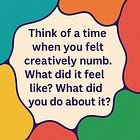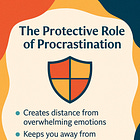10 Questions For Exploring How Your Art and Health Intersect
The relationship between creativity and mental health is far more complex and intertwined than most people realize. This free worksheet can help you explore what this looks like for you.

When I ask artists about their creative practice, something fascinating happens. They'll start talking about their medium or their latest project, but within minutes, the conversation inevitably turns to their mental health, their energy levels, their struggles with perfectionism, or how creating helps them process difficult emotions.
This isn't a coincidence. Your health and your creativity aren't separate entities that occasionally influence each other; they're completely intertwined aspects of who you are.
If you are interested in assistance in applying these ideas to your own life:
The Art-Health Connection Most of Us Miss
We live in a culture that treats creativity as either pure inspiration (the "tortured artist" myth) or pure productivity (the "content creator" grind). But neither of these narratives acknowledges the profound ways our wellbeing shapes every aspect of our creative lives:
How anxiety might make you create more urgently or freeze you completely
Why your art becomes darker during difficult periods (and whether that's helpful or harmful)
How chronic pain changes not just when you create, but how you create
Why creative blocks often coincide with mental health struggles
How your creative identity shifts when health challenges alter your capacity
Most artists I work with have never been asked to examine these connections directly. They notice the patterns intuitively but have never put language to them or understood how to work with these patterns rather than against them.
Why These Questions Matter Now
Right now, we're living through unprecedented levels of anxiety, depression, and creative burnout. The pressure to constantly produce content, combined with economic uncertainty and global stress, has created a perfect storm for unhealthy creative practices.
Add to this the fact that many artists are:
Working longer hours in uncomfortable positions
Comparing themselves constantly on social media
Monetizing their creativity out of necessity
Isolating themselves in the name of "creative focus"
Pushing through pain, exhaustion, and emotional overwhelm
The result? Many artists are unintentionally using their creative practice in ways that harm rather than heal.
But it doesn't have to be this way.
The Power of Conscious Exploration
When you begin to consciously explore the relationship between your art and your health, something powerful happens. Patterns that felt random or overwhelming suddenly make sense. Struggles that felt personal and shameful reveal themselves as common experiences with practical solutions.
You might discover that:
Your "creative blocks" are actually your nervous system asking for rest
Certain mediums regulate your emotions while others dysregulate them
Your best work happens when you honor your energy cycles rather than fighting them
Small adjustments to your creative environment can dramatically impact your wellbeing
The "complications" in your art health relationship aren't failures – they're valuable information
Starting Your Exploration
The 10 questions I'm sharing today are designed to help you begin this exploration. They're drawn from my research with hundreds of artists and my own journey of learning to create in ways that support rather than sacrifice my wellbeing.
These aren't diagnostic questions or a test with right and wrong answers. Think of them as a guided reflection that can reveal insights about your creative life you might not have noticed before.
Some questions might feel easy to answer, while others might bring up emotions or memories you weren't expecting. Both responses are valuable. The goal isn't to have perfect answers but to develop greater awareness of your unique patterns. You can download the 10 Questions Worksheet right here for free:
How to Use These Questions
Take your time. You don't need to answer all 10 questions in one sitting. Some might spark deeper reflection or even emotional responses. Feel free to pause, sit with whatever comes up, and return when you're ready.
Create as you explore. If questions trigger memories, insights, or emotions, consider expressing them through your preferred creative medium. Let the exploration itself become a creative process.
Look for patterns. After working through the questions, step back and notice what themes emerge. Where do you see opportunities for growth? What surprises you? What feels familiar?
Honor complexity. Your art-health relationship is as unique and complex as you are. Resist the urge to judge your answers or compare them to how you think other artists might respond.

What Comes Next
Understanding your art-health patterns is just the beginning. The real transformation happens when you begin to work with these patterns instead of against them – when you design a creative practice that honors both your artistic vision and your wellbeing.
This might look like:
Adapting your creative schedule to match your natural energy rhythms
Choosing projects and mediums that support your current mental health needs
Building sustainable creative habits that prevent burnout
Learning to recognize early warning signs when creativity becomes harmful
Developing a toolkit for staying creative during health challenges
The relationship between creativity and mental health will always be complex. But it doesn't have to be mysterious or overwhelming. With greater awareness comes greater choice and greater possibility for both healing and authentic creative expression.
I offer 1:1 Healthy Creativity Conversations to assist in going deeper into this work.
If you're interested in discussing what emerges from this exploration, learn more and book your free consultation here.




